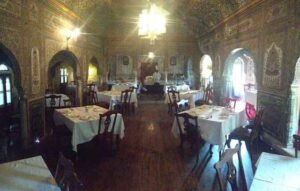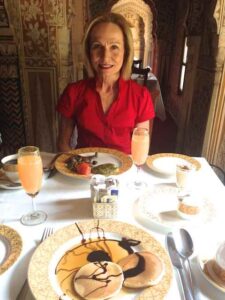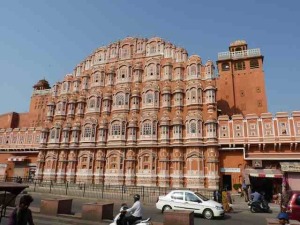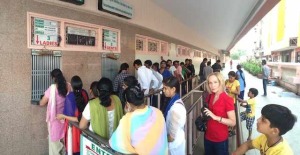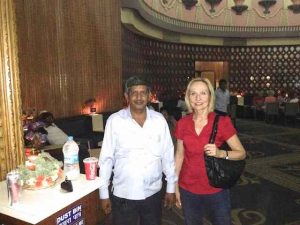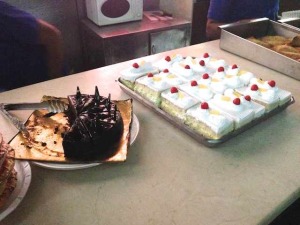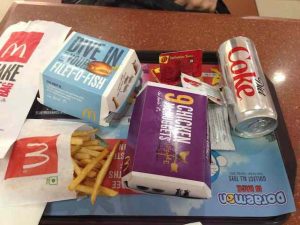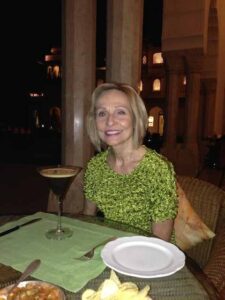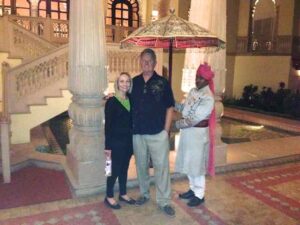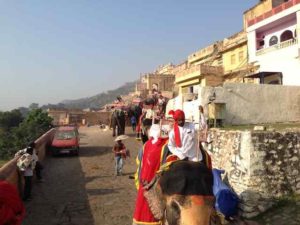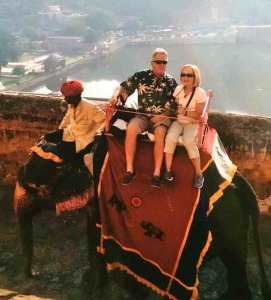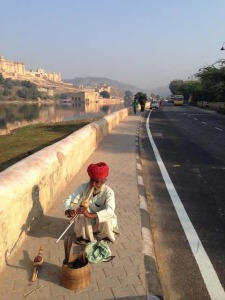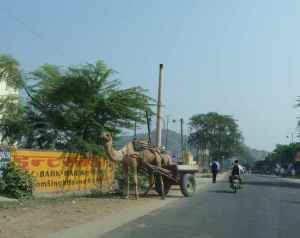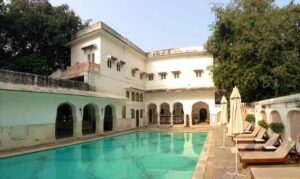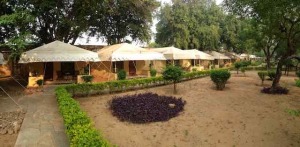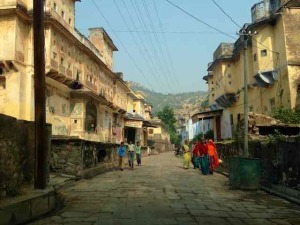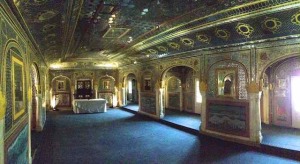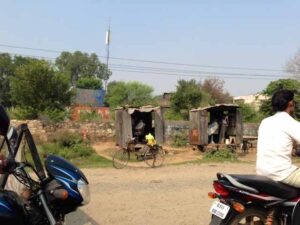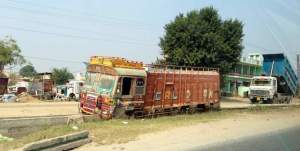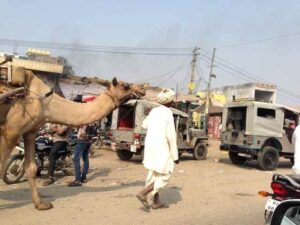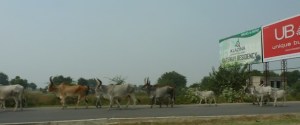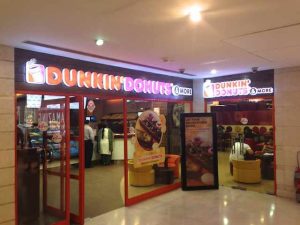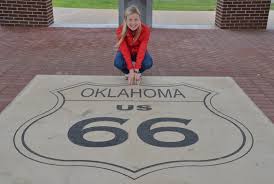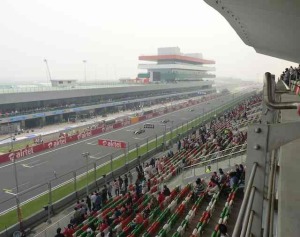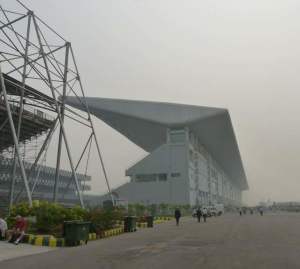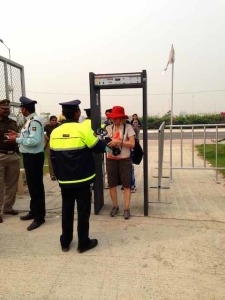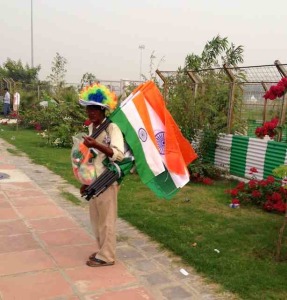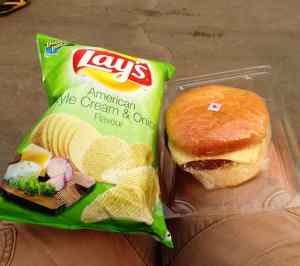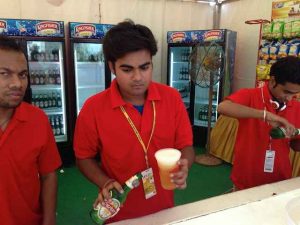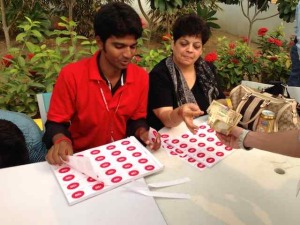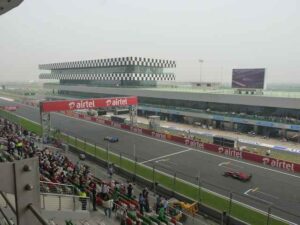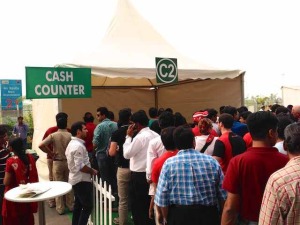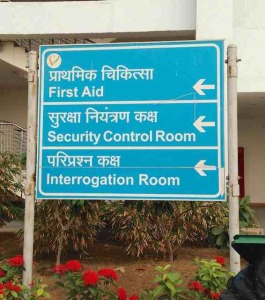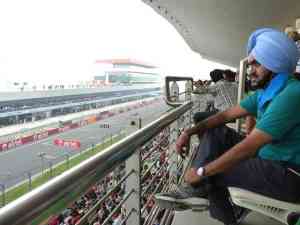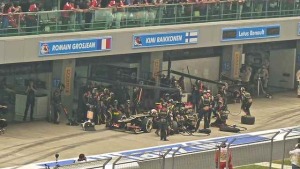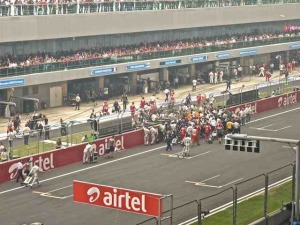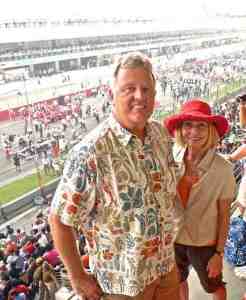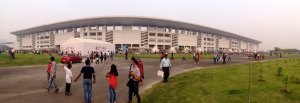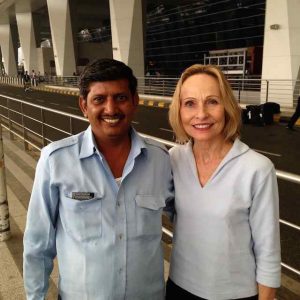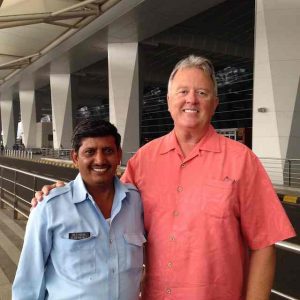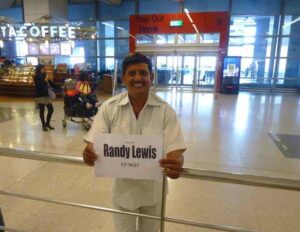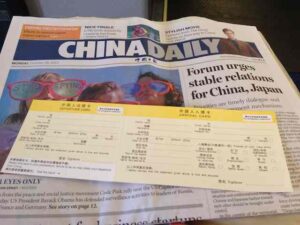|
This is my third and final posting from our trip to India. It sounds as if people are loving the photos. Some of you have been there and shared your experiences with me. Others told me they didn’t need to go now since they felt they have been to India “vicariously”.
My next couple of messages will deviate from travel for just a bit. I’ve got a great piece in the works about inflation….and the 2020 presidential election. Trust me it won’t be at all about politics.
At now on to India….part 3 and a trip to the Buddh International Circuit for the last ever, up to now anyway World Formula 1 Grand Prix in India.
India – Trackchasing Country #66
written by Randy Lewis October 7, 2014
Greetings from Noida, India
From the travels and adventures of the “World’s #1 Trackchaser”
Buddh International Circuit
Asphalt road course
Country #66 – Track #1,915

Click on this link:
The photo album from the second half of the India trip including the World F1 Grand Prix

Click on this link:
The video from the Grand Prix PLUS the sights, sounds and the overall assault to our senses
Thursday – Day 6 – Jaipur, India.
Opulent!
We began the day with a buffet breakfast in one of the most beautiful rooms where we’ve ever eaten. We would be spending two nights at the Samode Haveli Hotel. I’m so glad Alison convinced us to stay in Indian hotels. Delightful. Pictures tell it all.
Following breakfast, Raju was waiting to take us on a tour of the City Palace in Jaipur. Along the way, we were able to photograph the “Window” Palace as well. By now I was getting burned out on palaces. What I really wanted to do was coming up!
How many people get to do this? How many people THINK to do this?
Our son J.J. had recommended something most tourists would never think to do. He told us we had to visit the most famous movie theatre in India. CNN Travel lists the Raj Mandir movie theatre as the #3 “most enjoyable movie theatre” in the world! Carol and I go to the movies a lot. How could we miss it?
The theatre was built in 1976. It seats about 1,200. Tickets are sold separately to men and women. Carol bought three tickets (including one for Raju) since the line for women was shorter. Today’s Indian movie, “Boss”, was only in Hindi without English subtitles. Despite being in a foreign language we were able to keep up with the comedy/action movie.
Women in the last row!
It was surprising to see that women and their guests sit in the last few rows of the theatre. Men only sit in the first few rows. There are three types of seating, two box seat areas and “emerald” where we were (130 rupees – about $2). The theatre was similar to what you might find from a modern multiplex place in the states but only showing one movie. They didn’t sell popcorn but did have some unusual movie treats. The crowd really cheered when the hero beat up the bad guys and when the beautiful young girl came on the screen. It was the most fun experience. I’ve now seen movies in several foreign countries.
Ohso.
Indian movies are long typically about three hours. They usually have an interval or intermission. Ours did. During the interval, an Indian man engaged me in conversation. He was a nice young guy who was studying for his degree. He asked for my email address so he could send me info on his favorite author “Ohso”. Editor’s note: For several months my new friend DID send me emails about Ohso.
For research purposes only.
Following the movie, we walked across the street to McDonald’s. I think any Americans who eat in McDonald’s while traveling are either not very creative, scared to death to have new experiences or both and a lot more!
However, when I am in unique foreign countries (India qualifies!) I like to see what their McDonald’s might have that American outlets don’t. We certainly needed to try a Mickey D experience one time in a country where beef is not sold anywhere. Carol and I had a fish filet sandwich, chicken nuggets and “shake a sack” French fries. What are “shake a sack” French fries? The fries come with a packet of seasoning that is poured into the sack, then the fries are added and you shake! All good. Pictures…don’t miss ‘em.
The trackchasing lifestyle ain’t bad, is it?
Then we battled traffic, which is a tourist attraction in itself on the way back to the hotel. Raju picked us up in the evening for the short trip over to the Rambagh Palace Hotel. Condè Nast Traveler Magazine rated this hotel the #1 hotel in the world in 2009! There we had a drink in their elegant courtyard before having dinner in a real train car. It was a very pleasant evening under wonderful weather conditions. This trackchasing lifestyle ain’t bad, is it?
Delhi belly.
However, toward the end of the day, I had acquired a case of “Delhi belly”. This comes from eating or drinking things that have organisms that U.S. folks aren’t accustomed too. As I had been instructed at the first sign of this I needed to start taking the pills I had brought along for just such an occasion.
Friday – Day 7 – Jaipur, India.
Delhi belly day!
This is “Delhi belly” day! The urban dictionary describes ”Delhi belly” as “Diarrhea or dysentery contracted from eating Indian (i.e., from India) food”. My case was somewhat mild. However, “at the first sign of anything,” I was instructed to begin taking the pills that son in law James gave us. They did the job although I didn’t feel that well to be touring all day.
Have you ridden an elephant?
Our first official touring event was the Amber Palace. The highlight was riding an elephant to the entrance to the palace. Riding an elephant side saddle (with Carol of course) uphill for ten minutes is not the best thing for a person who doesn’t feel well. Nevertheless, I made it. Don’t miss the pictures. Trackchasing has now allowed me to ride both an elephant and a camel (Morocco). None of my fellow competitors have done that!
Of course along the way we encountered a “snake charmer”. No, I’m not talking about any present company. This was a real snake charmer. For a small fee he showed us his skills.
Elephants, camels and monkeys.
We did some touring of the palace (once you’ve seen one palace…..) but since I wasn’t feeling good we cut our tour short. Carol and I elected to walk down from the palace to the village below. We would meet Raju there. This was a 20-30 minute jaunt where we encountered elephants, camels and monkeys! Animals of all varieties roam freely (no tethering of any kind) including cows, brahma bulls, monkeys, pigs, dogs and anything else that feels like it.
You won’t get this feeling on a tour bus.
We had our first experience of walking along the road as traffic zipped past. Although we had passed thousands of pedestrians so far with Raju driving being the actual pedestrian was a scary feeling. We walked several blocks through a small village without seeing anyone who looked like us. You won’t get THAT feeling on a group tour.
When we finally found Raju it was a relief. Along the way we had come across a Citibank ATM. This was the only American bank ATM we would see during the entire trip. Since this is our bank we scarfed up 20,000 rupees, which should be enough to get us through the trip.
From Amber Palace to the “Elephant village” where the Amber Palace elephants reside and relax in a huge lake. The Indian government has stepped in for the protection of elephants. The number of rides allowed with each elephant is limited each day. The elephant village has special “houses” built for the elephant’s comfort. The lake is meant to replicate their natural environment.
With me not feeling well we canceled the rest of the day’s touring activity. We then set off for our country hotel, the Samode Bagh, located about 60 kilometers from the Amber Palace. In my condition, this 35-mile ride seemed like 350 miles. We arrived at the hotel by noon.
Nothing if not hipsters.
Samode Bagh is in the State of Rajasthan in North India. Another way of saying it is the hotel truly is in the middle of nowhere. The “Independent” describes the place as being one of “The 50 best hip hotels around the world.” Carol and I are nothing if not hipsters. The Samode Hotel group has eight hotels in its exclusive hotel group. Again, we have Alison Jackson to thank for turning us on to these unique Indian accommodations.
Our hotel room had a tent roof!
The Samode Bagh, built some 250 years ago, is a former hunting lodge used by the King of India. It’s located in what is now the Samode Palace Hotel, which of course was the king’s palace. The Samode Bagh, with its 44 rooms, was converted into a hotel in just 2001. Each room is a separate cottage with a TENT roof. Like many of the items, I am describing I recommend you see the pictures.
I wasn’t feeling up too much at this point. Just after check-in we went to bed and didn’t get up until the next morning. I think getting 15 hours of rest was just what the doctor would have ordered.
Admin work in the midst of adversity.
I did wake up a time or two during this time to do some “admin” work. I had to reorder from Amazon my purchase of a new (actually used) Panasonic Lumix FZ 35 camera. My current model has been great – about 200,000 photos. However, recently the flash failed and on this trip, the LCD monitor went out. I can still take pictures and videos but without those two options. A new camera would cost nearly $500. However what was described as “nearly new” cost only $180 on Amazon. I’m not one for buying used stuff of any kind but with my iPhone taking over a good deal of my photo and video usage nowadays I probably don’t need to spend $500 on a new camera. Editor’s note: When I received my camera from Amazon that was absolutely no way to tell it wasn’t brand new. Opening up the product case was EXACTLY like opening up a brand new camera!
What can’t technology do?
From time to time I will be on the road and remember I forgot to record a favorite and/or anticipated TV program. I watch 95%+ of my TV viewing on a recorded basis. Why do that? I want to watch the program when I want to watch it not necessarily when it airs. Additionally, I want to be able to watch 60 minutes of programming in 40-45 minutes without having to see commercials. That’s not too much to ask, is it?
That being the case I used my iPhone Direct TV app to program my DVR (digital video recorder) to record the UCLA football game back home. A few years ago who would have thought something like that could be done let alone be done from India.
I also sent photos from our trip via my iPhone app “Photostream” to family and friends as I have been doing daily. Then I finalized hotel reservations for my upcoming international trackchasing visit before going back to sleep. All of these electronic chores had been done from India using only my iPhone!
Saturday – Day 8 – Samode, India.
The most beautiful room in Rajasthan.
We had a loving buffet breakfast in the dining hall of the Samode Bagh. This was a huge space again with a tented roof. I was feeling a bit better today and ready to take on the touring world of India as we were getting closer to race day, which is now tomorrow.
Our first stop was to take a look at the Samode Palace Hotel. The Samode Palace was a sister hotel to the one we were staying in. This palace had been converted into a hotel in 1987 and has 43 rooms. Alison had recommended we come here to see the hotel’s, Durbar Hall. She described it as the most beautiful room in all of Rajasthan. The general manager of the Samode Palace arranged for a private tour of the hotel for us. Yes, as far as I know, the Durbar Hall is the most beautiful room in Rajasthan. Check out the pictures!
The long drives we took were tourist attractions in themselves.
Following this stop is was a 5-hour journey back to Delhi. Some of the drives were long but also the most entertaining as we drove through small villages. Here we got our best opportunity to see the local cultures and what people do on a daily basis.
We saw dozens of these.
One of the most unusual items was seeing small wooden shacks about 6’ by 6’ in size. These were barber shops! Inside we could easily see men getting a shave from a barber wielding a straight razor. I don’t think, in this part of the world, I would want anything to do with a straight razor being wielded around my throat.
Good brakes, good eyes and good luck.
Raju continued to do a great job with driving under the most difficult traffic conditions I have ever seen (by a factor of several). Raju says a good driver in India needs three things: Good brakes, good eyes and good luck!
The entire drive was like a huge video game where obstacles jump out in front of you at the very last minute. Years ago we took an Asian cruise to countries like Indonesia, Malaysia, and Vietnam, etc. The best aspect of the travel was taking 50-mile rides at 20 M.P.H. from the cruise ship through the small towns to our final destination which was usually a big city like Saigon aka Ho Chi Men City, Jakarta, or the like.
The same is true for India. We rarely drove faster than 40 mph and often much slower. This gave us plenty of time to see the “local life”. Days like this were the best. To make it even better we did know at the end of the day we would be staying in first-class hotels.
A private driver was worth millions.
Raju stopped whenever and wherever we asked. That’s the benefit of a private tour. Each day we stopped at a local Indian highway restaurant for lunch. The food was good but Indian food in the U.S. is probably better.
We will be back at the Sheraton Delhi tonight and tomorrow night our final evening in India. We were at this hotel for night #1 as well.
When Raju dropped us off at the hotel this afternoon I gave him a large tip so he could take his wife to dinner tonight and relax. He said he can sometimes go up to 60 days driving people all over India without getting home! However, in June he takes the family to the mountains and the snow.
Tonight it was up to the Sheraton lounge for cocktails and hors d’oeuvres. It’s hard to believe we have such luxury with so much poverty right outside the window. Carol was most uncomfortable with that fact.
We took a few minutes to check out the “European” style mall as Raju described it next to the Sheraton. We wanted to see another movie but times did not fit our schedule. We needed to clear metal detectors to get in the mall and hotel. That will be in the U.S. before you know it. We had a Dunkin Donut in the mall and called it a night!
By the way I don’t think I have mentioned this up to now. We were staying in grand hotels everywhere. Where did Raju, our driver stay overnight? There are “driver” hotels. I imagine these places to be like hostels where several people live together in a “hotel” environment. I do know this. Whenever Raju dropped us for the night he was always waiting for us at the agreed-upon time. Yep. Raju rocked it.
Sunday – Day 9 – New Delhi, India.
66 in 64.
For just the 66th time in my 64 years of life, I’ve been able to wake up and say “I’m going trackchasing in this country for the very first time”. Granted I have not always made that statement when trackchasing in a country for the first time….but I could have.
100! Nobody’s even close.
India will forever be known as a very special trackchasing country for Carol and me as a couple. India is my 66th trackchasing country. India is Carol’s 34th trackchasing country. What does that add up too? 100! Yep, Carol, and I now have 100 combined trackchasing country visits. How does that compare to our fellow trackchasing couples? No couple has seen as much as half that number.
This had been like having my teeth pulled.
I had ordered our tickets to this race a few months ago. Getting the tickets online wasn’t easy. The official tourist agency selling the tickets wouldn’t accept ANY of my credit cards online when I tried to buy the tickets. Then I followed up with that agency on the phone. I spent a minimum of two hours on the phone, via a pay call, to India. No luck! They never could get my order straight.
Then Alison Jackson forwarded me the website address of Gotickets.com. She was thinking I could get my tickets through them and I did. It came to my attention during the ordering process that I had used these people for our Singapore F1 tickets.
How much would the race tickets be?
Up to know the most I had ever paid for a race ticket was $200 U.S. That was for the inaugural F1 event in South Korea. I bought that ticket from a scalper with the ticket having a face value of more than $600 U.S.
Like South Korea, I was again looking to buy tickets in the main grandstand. From there we could see the pit stops, all of the pre-race ceremonies and the standing start of the F1 race itself. A lap around the Indian track would take about one minute and twenty seconds. How much time would we see the cars (at least where we could identify them) racing in a single lap? The answer: about eight seconds! I guess that as big a reason as any on why I don’t like F1 racing but I do like the “spectacle” of F1 racing.
A new record!
I paid about $220 U.S. for each of our tickets. On top of that, I purchased a parking pass for our driver for about ten bucks. Earlier in the trip, we picked up the tickets at just about the most rustic construction trailer I can ever recall seeing.
Race time was 1500 or 3 p.m. for you civilians. There would also be a preliminary race at 12:30 p.m. We left the hotel at 9:30 a.m. expecting to get to the track about 11 a.m. Along the way, Raju had to stop and pay a tax because we were moving from one Indian state to another. We did that several times during the trip. Raju told us that if the tax were not paid then the fine if he were stopped, would be nearly ten times the cost of the tax and his insurance would be invalid. Race traffic was heavy but it was probably just normal New Delhi Sunday traffic.
The third and final version.
This would be the third running of the World Formula 1 in India with the first race being held in 2011. The local papers said that the first race attracted 95,000 spectators and last year’s race 65,000. We were surprised, although it was early, how few people were at the track today.
F1 will not be racing in India next year. The original contract called for five years of F1 racing in India. However, some type of dispute will limit this to likely being the last year of F1 racing in India at least for the time being. India is not on the 2014 F1 schedule. I have now seen racing in all countries currently on the F1 schedule. This includes F1 main event racing in Las Vegas, South Korea, Singapore and now India.
Some trackchasers just wimp out.
Admittedly, I am not a big fan of F1 racing. However, when I go to an F1 venue on an F1 weekend you can bet I’m going to the main event. Some of my fellow competitors will “wimp out” and go to see racing on a preliminary day. They do this to save money. By the way, these same people will spend $200 in gas to see a 30 M.P.H. figure 8 race 400 miles from home but they won’t spend the money to see a major league main event! Then they crow that they went trackchasing on “Monaco Grand Prix weekend” or whatever. Oh my. If you can afford to get to a foreign country F1 track on the weekend when the F1 group is in town you should be able to afford to see them race. With some folks, if you don’t read between the lines you will miss the real story! Some might recognize this as a Guy Smith tactic. If you do then that’s on you.
Not much of a spectacle.
I was expecting a “spectacle” from the Indian Grand Prix but they missed the boat badly, very badly on the spectacle part. I’ll try to list all of the areas where today’s program fell short. Maybe because it’s the last year of the event the promotion team had simply given up.
In South Korea and Singapore, there was a LOT going on to support the event. When I come to one of these big shows I want to look over the souvenirs and eat the local foods offered at F1 events. Who knows when I will be back this way?
Oh my….this can’t be true.
When we arrived we needed to clear metal detectors, which is not unusual. I have no problem with that. It seems like a good idea in today’s world. However, I have never seen a policy forbidding food or drink which was purchased at the track from being brought into the grandstand. That’s right! You could buy concessions at stalls behind the grandstand. You just couldn’t bring your track purchased food and drink into the grandstand! I’ve seen racing at about 1,900 locations. I have NEVER heard of such a policy. It was fun watching fans argue with security guards when they first learned of this prohibition.
I had to have a racing souvenir from India.
The first stop would be for souvenirs. They were selling an event program for about $15 U.S. However, I no longer collect programs as I don’t have space to store them. I wanted a shirt or a cap or a flag from India. Surely, they would have something that would meet this need. Only the guy pictured above was selling souvenirs and that was outside the race track gates.
Sadly, there was only one small souvenir area selling anything. This included the Red Bull and Ferrari brands and a couple of other lesser brands. None of their stuff was unique to India however. The entire length of this souvenir area could not have been more than 30 yards long. This was the ONLY souvenir area we saw at the entire track. I ask the folks reading this who have been to an F1 event….have you ever heard of such a thing?
There was not a single shirt, hat or flag with the Buddh International Circuit name on it. Inside the track, there was nothing that said a single thing about India being sold as a souvenir. Nothing! I couldn’t believe it.
Where was the shrimp masala?
Having struck out with souvenirs we considered lunch. There must be some savory food stalls featuring India delights right? Nope. There was one menu of food and drink items that were sold at EACH concession stand. This included three chicken sandwich type items, some potato chip offerings (which I think went under the name “wafers”) as well as a “vegetable puff” and brownie. Beer, soft drinks and bottled water were on sale.
However, we couldn’t just walk up to a concession stand, order our food and pay cash. We needed to go to a special “cash sales” area. There we exchanged cash for coupons. If our food and drink order was expected to come to 750 rupees then we needed to buy that amount of coupons. That didn’t leave much room for impulse purchasing at the food counter did it?
Just in case a typhoon blew in before the main event.
We decided to go into the main grandstand first to watch the one and only preliminary race. This featured about 15 formula type cars (not dissimilar to Indy cars) racing for 10 laps or 25 minutes whichever came first. This race “showcased” another feature that made today’s event “unspectacular”.
Not until the race was finished and the victory interviews took place was there ONE word spoken over the public address system. Even the lowliest of short tracks in the U.S. have an announcer and P.A. system. In India nothing!
At least once we had seen the green flag drop on this preliminary race India was “countable”. This was important. When I went to the F1 race in Korea the main event was nearly rained out. However, I had seen the preliminary race making the Korea track countable even if the F1 main event had been weathered out.
A line is not a line in this part of the world.
With a couple more hours until the F1 race, it was time for lunch. Now the lines to buy food coupons were long. Indians, as well as Europeans, are not the most respectful of the process of waiting in line. Carol and I constantly raise our eyebrows at folks from these regions “sliding” into the middle of the queue. I’d like to see these people try cutting in line in Middletown, New York.
With 800 rupees of food coupons in hand, we then stood in another “push and shove” line to get our food. However, as luck or poor planning would have it, the concession stand was out of several food items. Normally this would not have been a problem. However, since we had purchased food coupons for specific items we now had a minor problem.
We ended up with two chicken burgers with cheese, two packages of Frito-Lay potato chips (wafers I think) and two bottles of Aquafina water. At least PepsiCo Inc. was getting their cut today.
Amazing but true.
Next, we came to another hassle that was nearly impossible to believe. None of our food and drink could be taken into the main grandstand! Have you ever heard of such a thing? I have now been to 1,914 tracks. I can’t think of any of those places that had a complete ban on food and drink in the seating area. OMG.
I was nearly at the end of my rope.
We tied to find a curb to sit on to “enjoy” our lunch. We were shooed away from the first curb we selected by a rental cop. By now my fuse was getting a bit short. I yelled at him, “You guys have too many rules….way too many rules”. Alas, I don’t think he spoke English. That might have been a good thing. There were several signs today pointing toward something called “Interrogation room”. OMG.
I studied their weaknesses.
We finished our pre-packaged very dry and stale chicken burgers while sitting on a dirty curb. We ate one bag of chips. The bottled waters were large. We couldn’t drink them all in one sitting. I kept an eye on the security guards turning race fans away who tried to enter the grandstands with food and/or drink. What were the guard’s weaknesses? I’m pretty sure I would have made a good prison inmate. Maybe, there’s still time!
First I crammed the potato chip bag into my camera bag. Then I noticed that the guards were beginning to let people into the stands with their bottled water. That was a good sign. I sent Carol ahead to test out the new “bottled water policy”. She made it through. That meant I could remove the bottled water from inside my cargo shorts. That was a relief! Soon we were in the grandstands and heading toward our seats.
This event had come up short so far. First, they had no souvenirs from the track or India at all. Then they made it as inconvenient as humanly possible to buy anything to eat and drink. On top of that, they didn’t have much that seemed worth eating and drinking. We had just one thing left. How would the racing be?
As Joe Friday told us each week on Dragnet….”Just the facts mister”.
I have a lot of European friends and other folks from countries I have met during my travels. Many of them are huge F1 fans. I don’t want to offend them. I hope I don’t with my analysis of today’s racing.
We had perfect “A #1” seats. We were about midway up in the center of the main grandstand. I don’t think anyone at the Buddh International Circuit had a better seat location especially for the pomp and circumstance that comes from the gridding and start of an F1 race.
Sebastian Vettel from Germany, a three-time F1 champion, was starting on the pole for this event. We couldn’t have been but a few yards from where he would start the race. We had a great view of where most of the cars would make their pit stop. In an F1 race they don’t refuel the cars. They just change tires. A four-tire pit stop takes about four seconds!!!
Where was the pre-race activity?
There was very little pre-race activity from the locals like there had been in my previous F1 visits. However, it is quite amazing how much “stuff” the F1 pit crews bring onto the track as pre-race preparation. Don’t miss the pictures and video. It is quite a sight when the horn blows and the 10-15 man crews and all of their equipment for 22 cars have to disappear from the track in a matter of about 60 seconds.
Sebastian Vettel is the “Babe Ruth” of F1 racing right now. He’s just 26 years old but has won the last three F1 championships. Following today’s race, there are three more F1 events in the 2013 season. Vettel was so far ahead in the championship standings that he could win the championship today if he finished well. Can you imagine a NASCAR champion locking up the championship with three races to go!
If only she could do that every day.
F1 racing is extremely loud. Carol never wears ear defenders aka earplugs. However, today she had the good sense to listen to my advice. If only she could do that every day! She wore earplugs.
Probably the most exciting element of any F1 race is the start. All 22 cars start from a “standing start” just like they did at the Peoria Speedway when I first started watching racing at about five years of age.
Precisely at 3 p.m., they were off. They would be racing for 60 laps. Each lap took about 80 seconds so the race would last about 80 minutes. One nice positive about F1 racing is they don’t have much in the way of full course yellow flags. Yellow flags can kill American short track racing. Today they didn’t have any full course yellows.
You do the math.
In the 60 laps of scheduled racing we would see about eight seconds of racing per lap. We could see cars moving along the backstretch and in one sweeping turn. However, at those points, the cars were so far away it would have been impossible to identify them. That meant we would see the cars during the ENTIRE race for about 480 seconds or eight minutes. At $220 U.S. per ticket, you can do the math.
Sebastian Vettel led the first couple of laps before pitting to get rid of his soft tires. This put him in about 16th place. Good. That would make things more interesting.
Hear no race; see no race.
Before I go any further did I tell you that most of the time we had no real idea what was happening in the race? They did have a video board but the writing was so small we had to squint to see what position each driver was in. There was some audio feed from the TV commentating but the sound was too low for us to hear any of that.
It wasn’t long before Sebastian Vettel had resumed being the leader of the race. He would go on to win the event by more than 29 seconds over the second-place driver. Can you imagine anyone in today’s NASCAR world winning a race by 29 seconds? Can you imagine anyone winning a race at your local short track by that margin? Nope. Even in your wildest dreams, you couldn’t imagine that!
One of the cooler things was when Vettel drove down the front stretch after winning and did a tire-smoking donut spin. The crowd went wild. Then Sebastian got out of his car and bowed in front of his race car. I read the next day in the papers that he and his Red Bull team were fined 25,000 euros for this celebration! OMG.
I don’t think this is much of an idea.
This event left a whole lot to be desired. However, Carol and I had seen a race in India. Did you know that no other trackchaser has ever seen a race in this country? I’m discounting professional race drivers who have raced here. Some trackchasers think that adding in people (pro drivers) who have never ever heard of the hobby of trackchasing in group totals is a good idea. I don’t.
Following the race, it was easy to find Raju our driver. He had spent the day with some of his fellow drivers just hanging out while we enjoyed our day at the races. Getting out of the track and its traffic wasn’t too bad. However, when we got back into Delhi we faced Sunday night traffic there. It was chaotic, to say the least.
Event organizers, according to the local paper, estimated today’s crowd at 60,000. The main grandstand was nearly full as well as a grassy hillside area near turn one. However, I saw two main grandstands that looked as if they could have seated 50,000 with nary a single soul in them. I doubt very much they had 60,000 fans here today.
Finally we could eat and drink.
When we got back to the Sheraton Delhi we headed straight to the Sheraton lounge. There we enjoyed our wines (Carol always red, me almost always white) and fried prawns. When we got back to the room the hotel had special chocolate treats waiting for us. Trackchasing on the road isn’t all bad is it?
What’s one of the best things about trackchasing?
Please don’t get me wrong in my analysis of today’s event. I wouldn’t give up this one-time experience for anything. Mind you I would be flying 40 hours round-trip to get here. I would be spending thousands of dollars to tour the country for ten days. Would I ever come back to this venue for this event? Not on your life! That’s what so great about trackchasing. If you don’t like what you saw then you never have to come back. That doesn’t mean we won’t come back to India someday. I hope we do. However we still have tens of countries to visit before India becomes a #1 draft pick again.
Monday – Day 10 – New Delhi, India to Guangzhou, China to Los Angeles, California.
Sit back and be quiet…for 27 hours.
Considering how chaotic the first part of our trip went (Indian visa problems) getting home went as smoothly as I could have expected. Today would be a very long day. We started at 7:30 a.m. New Delhi time on Monday. We would not reach the driveway in San Clemente until about 10 a.m. New Delhi time on Tuesday! That’s nearly 27 hours of traveling.
The private Sheraton lounge provided breakfast. What a special situation I have with so many of my travel partners. Having “advantages” which sometimes take years to establish can make all the difference during these trips.
I am a “gold” member of the Sheraton “Starwood Preferred Guest” program. Not only does that provide special prices for accommodations but other benefits accrue as well. We always get free Wi-Fi when we travel with Sheraton internationally. At $10-15 per day that can add up over a week’s travel or a year’s worth of stays.
For our trip to New Delhi, we were granted complimentary access to the Sheraton lounge 24/7. In the morning they served a beautiful breakfast buffet from the top floor of the hotel with 180-degree views of Delhi. Special tea service was available from 2-4 p.m. each day. However, we were always touring during these hours. Then in the evening, from 6-8 p.m., we were treated to drinks and hors oeuvres. Each night we stayed at a Sheraton we stopped for wine and finger food, which sometimes meant dinner. Today we had breakfast.
We didn’t want to say good-bye.
Then at 8:30 a.m. Raju picked us up for the last time. I’ve had drivers in the past. This is always a sad time when good-byes must be said. Raju had done his job perfectly. He wasn’t the best English speaker. That was fine. When you travel more than 800 miles with someone you don’t want to be talking non-stop.
Driving in India is over the top, well over the top. There is NO WAY I could have driven in India. As a point of fact, I don’t know anyone who could have driven in India! I challenge ANYONE to do the trip we did and drive themselves. Raju navigated the impossible at seemingly every turn for a full week covering more than 1,200 kilometers. When we wanted to stop somewhere he stopped. When we were hungry he took us to just the right place. Raju was a perfect driver for us.
Raju rocked!
When we reached the airport it was time for me to pay Raju. For all of this time, there was no advance payment or any payment at all until the trip was complete. The fee for having a driver was possibly the best bargain of the trip.
Alison Jackson, my U.K. travel contact, had quoted a charge of 28,000 Rupees (about $475 U.S.) for our eight days with Raju. Let me tell you what that included. First, Raju was on call 24/7 to take us anywhere we wanted to go. The fee included all petrol (800 miles of driving at about $5 U.S. per gallon), all tolls (we probably spent $50-75 U.S. in the many toll stops), and all taxes – every time we changed Indian states we paid a tax. These taxes probably amounted to another $30-50 U.S. or maybe more. When we weren’t overnight in Delhi Raju stayed at local guest houses. He told us he paid anywhere from 250-400 rupees ($4-6 U.S.) per night. This was included in our fee as well.
Rental cars in foreign countries are often more expensive than what would be charged in the U.S. It’s not unusual to pay $40-60 per day or more for a foreign rental car. Insurances, if paid, can also be very expensive. In some places, there are road stickers that must be bought and can be very expensive.
All of the above expenses likely add up to the entire fee Raju was paid and more. However, the real “added value” from Raju was his driving and guiding skills. He could answer all of our questions along the way. As mentioned if we wanted to stop we stopped. If we did or didn’t want to do something on the trip’s “programme” then we did or didn’t do that activity. You won’t get that option with a group tour. Often Raju interpreted the Hindi language when we needed it most.
I paid Raju his fee in a combination of Indian rupees and U.S. dollars. Then I gave him a very large tip. He was happy with the money but his main question was “Were you happy with Raju?” We were indeed!
Just 20 hours of flying and we’re home.
New Delhi’s international terminal is brand new and luxurious. We easily found the China Southern Airlines counter. We would be flying in coach class from New Delhi to Guangzhou, China (China Southern airline hub) and then onto Los Angeles. The first flight would be about five hours long and the final leg about 15 hours.
Bags checked on China Southern were free which is often the case with international travel. When I asked for emergency exit row seating and they could not have been more accommodating. We were given seats in bulkhead rows. This provided 3-6 feet of legroom where other passengers had 3-6 INCHES of legroom. Folks, I’ve found that if you can put together a string of small advantages in life they start to add up rather quickly.
And off we went.
Just before we left the check-in counter, the airline rep put a small round sticker with the airline logo on each of our sleeves. I told Carol her sticker said in Chinese “I’m a big moron and if you find me wandering the halls of the airport take me to the nearest departure gate”. Then she told me that my sticker said the same thing but focused on my being the “biggest moron” in the airport. And off we senior citizens went for the last leg of our ten-day journey!
We spent the last remnants of our Indian rupees on some souvenirs for the family which is what we always do. Then it was time to leave for China. We had just an hour layover in Guangzhou before leaving for Los Angeles.
When we landed in the beautiful new Tom Bradley International terminal we grabbed our bags, then our car and headed straight for…..In n Out Burgers! Yep! India doesn’t do beef. In N Out Burgers does!
If you’ve read this far you know we’ve had a grand trip. I hope YOU had a grand trip just reading about it. Trackchasing country #66 is in the rearview mirror. Can country #67 be far off? No, it cannot.
Thanks for reading about my trackchasing,
Randy Lewis
World’s #1 Trackchaser
Life should NOT be a journey to your grave with the intention of arriving with a well-chiseled and honed body but rather to crash in, riding your golf cart up the 18th fairway with a glass of single malt in one hand and a brownie in the other. You should be totally worn out and used up with a tattoo on your chest proclaiming, “What a ride”.
P.S. I suspect that most of you will never visit India. If you don’t then I hope the above diatribe makes it feel as if you have visited India. If you do decide to go then you had best call me. I will put you in touch with Alison Jackson. She will make your visit to India the very best. Maybe you will be lucky enough to have Raju as your driver.
P.P.S. Special thanks to son J.J. who helped save this trip from the “Jaws of defeat” at literally the 11th hour.
Trackchasing truly has taken me all over the world!
THE COUNTRY LIST
#66!!
RLR – Randy Lewis Racing Lifetime Trackchasing Countries
# 1 – UNITED STATES OF AMERICA – Peoria Speedway – Mt. Hawley, (oval) – Track #1, Peoria, Illinois – circa 1954 (age 5)
# 2 – CANADA – Cayuga Speedway (oval) – Track #174, Nelles Corner, Ontario, Canada – July 31, 1988 (Dick Trickle winner)
# 3 – AUSTRALIA – Parramatta City Raceway (oval) – Track #180, Granville, New South Wales, Australia – November 17, 1989 (accompanied by Carol)
# 4 – UNITED KINGDOM – Northhampton International Raceway (oval) – Track #378, Northhampton – June 26, 1999 (accompanied by Carol, Kristy, Jim)
# 5 – NETHERLANDS – Driesum Racetrack (oval) – Track #839, Driesum – May 5, 2005 (accompanied by Roland Vanden Eynde)
# 6 – BELGIUM – Bellekouter oval (oval) – Track #841, Affligem – May 8, 2005 (accompanied by Roland Vanden Eynde)
# 7 – FRANCE – Circuit de Croix en Ternois (road course) – Track #843, Saint-Pol sur-Ternoise – May 8, 2005 (accompanied by Roland Vanden Eynde – 2nd new country in one day!)
# 8 – GERMANY – Nurburgring (road course) – Track #844, Nurburg – May 13, 2005 (accompanied by Carol, Roland Vanden Eynde)
# 9 – NEW ZEALAND – Western Springs Speedway (oval) – Track #1,134, Western Springs – December 26, 2006 (accompanied by Carol)
# 10 – MEXICO – Triovalo Bernardo Obregon (oval) – Track #1,281, Tiajamulco de Zuniga, Jalisco – October 14, 2007 (accompanied by Carol, J.J., Roger Ward)
# 11 – BARBADOS – Bushy Park Racing Circuit (road course) – Track #1,296, Bushy Park – December 9, 2007
# 12 – THAILAND – Bira Circuit (road course) – Track #1,300, Pattaya – January 19, 2008
# 13 – SOUTH AFRICA – Durban Grand Prix (road course) – Track #1,315, Durban, KwaZulu-Natal – February 24, 2008 (accompanied by J.J. and Will Van Horne)
# 14 – JAMAICA – Dover Raceway (road course) – Track #1,322, Brown’s Town St. Ann – March 24, 2008
# 15 – SWEDEN – Sturup Raceway (road course) – Track #1,335, Malmo – May 10, 2008 (accompanied by Carol)
# 16 – DENMARK – Ring Djursland (road course) – Track #1,336, Tirstrup – May 11, 2008 (accompanied by Carol)
# 17 – CZECH REPUBLIC – Automotodrome BRNO (road course) – Track #1,381, Brno – September 13, 2008
# 18 – AUSTRIA – Lambrechten Stock Car Track (road course) – Track #1,382, Lambrechten – September 14, 2008
# 19 – IRELAND – Tipperary International Raceway (oval) – Track #1,388, Rosegreen – October 26, 2008 (Carol and I visited this track earlier in the year)
# 20 – GUYANA – South Dakota Circuit (road course) – Track #1,390, Timehri – November 2, 2008 (accompanied by Carol)
# 21 – CHINA – The Guia Circuit (road course) – Track #1,392, Macau – November 16, 2008 (accompanied by Carol)
# 22 – COSTA RICA – Autodromo La Guacima (road course) – Track #1,398, La Guacima – November 30, 2008
# 23 – ANDORRA – Grandvalira Circuit (road course) – Track #1,404, Port d’Envalira, Andorra – January 17, 2009
# 24 – ARGENTINA – Circuito Efren Chemolli (oval) – Track #1,406, Buenos Aires, Argentina – January 31, 2009 (shared with Jerry Fisher)
# 25 – QATAR – Losail International Circuit (road course) – Track #1,408, Doha, Qatar – February 13, 2009
# 26 – BAHRAIN – Bahrain International Circuit (road course) – Track #1,410, Sakhir, Bahrain – February 27, 2009 (accompanied by Carol)
# 27 – UNITED ARAB EMIRATES – Dubai Autodrome (road course) – Track #1,411, Dubai, United Arab Emirates – February 28, 2009 (accompanied by Carol)
# 28 – COLOMBIA – Autodromo de Tocancipa (road course) – Track #1,415, Tocancipa, Colombia – March 22, 2009
# 29 – SPAIN – Motorland Aragon (road course) – Track #1,416, Alcaniz, Spain – March 28, 2009
# 30 – PORTUGAL – Circuto de Murca (road course) – Track #1,417, Murca, Portugal – March 29, 2009
# 31 – ICELAND – Kapelluhraum (road course) – Track #1,420, Hafnafjorour, Iceland – April 25, 2009 (shared with Will White)
# 32 – HUNGARY – Hungaroring (road course) – Track #1,426, Mogyorod, Hungary – May 8, 2009 (accompanied by Carol)
# 33 – SWITZERLAND – Hock Ybrig (road course) – Track #1,427, Hoch Ybrig, Switzerland – May 9, 2009 (accompanied by Carol)
# 34 – ITALY – Vighizzolo d’Este Stock Car Track (road course) – Track #1,428, Vighizzolo d’Este, Italy – May 10, 2009 (accompanied by Carol)
# 35 – DOMINICAN REPUBLIC – Autodromo Mobil 1 (road course) – Track #1,515, Santo Domingo, Dominican Republic – December 6, 2009 (accompanied by Carol)
# 36 – MALTA – Ta’Qali Race Track (road course) – Track #1,521, Ta’Qali, Malta – February 7, 2010 (accompanied by Carol)
# 37 – FINLAND – Lake Pidisjarvi Ice Track (road course) – Track #1,524, Nivala, Finland – February 20, 2010
# 38 – JAPAN – Suzuka Circuit (road course) – Track #1,530, Suzuka, Japan – March 21, 2010
# 39 – CHILE – Autodromo de Interlomas (road course) – Track #1,531, Temuco, Chile – April 18, 2010
# 40 – MOROCCO – Circuit de Marrakesh (road course) – Track #1,535, Marrakesh, Morocco – May 1, 2010 (accompanied by Carol)
# 41 – BRAZIL – Circuit de Caruaru – Aryten Senna (road course) – Track #1,540, Caruaru, Brazil – May 16, 2010 (accompanied by Carol, Jerry Fisher and Katina Spencer)
# 42 – ESTONIA – Laitse Rally Park (road course) – Track #1,571, Laitse, Estonia – July 24, 2010 (accompanied by Carol)
# 43 – LATVIA – Bikernieki (road course) – Track #1,572, Riga, Latvia – July 25, 2010 (accompanied by Carol
# 44 – GUATEMALA – Autodromo Pedro Cofino (road course) – Track #1,580, Alotenango, Guatemala – August 15, 2010
# 45 – EL SALVADOR – El Jabali (road course) – Track #1,582, Quezaltepeque, El Salvador – August 22, 2010 (accompanied by Carol)
# 46 – ROMANIA – Bradu (road course) – Track #1,603, Bradu, Romania, El Salvador – October 16, 2010
# 47 – BULGARIA – Closed Route – Burgas (road course) – Track #1,604, Burgas, Bulgaria – October 17, 2010 (accompanied by Lyubomir and Plamen Simeonov)
# 48 – SOUTH KOREA – Korea International Circuit (road course) – Track #1,605, Yeongam, Jeollanam-Do, South Korea – October 24, 2010
# 49 – PHILIPPINES – Batangas Racing Circuit (road course) – Track #1,608, Batangas, Philippines – November 21, 2010
# 50 – NORWAY – Lyngas Motorbane (road course) – Track #1,648, Lier, Norway – April 30, 2011
# 51 – MALAYSIA – Sepang International Circuit (road course) – Track #1,656, Sepang, Malaysia – May 28, 2011
# 52 – INDONESIA – Sentul International Circuit (road course) – Track #1,657, Babakan Madang, Boder, Indonesia – May 29, 2011
# 53 – LUXEMBOURG – Alzingen (road course) – Track #1,711, Alzingen, Luxembourg – September 4, 2011 (accompanied by Carol)
# 54 – POLAND – Tor Slomczyn (road course) – Track #1,713, Slomczyn, Poland – September 11, 2011 (accompanied by Carol)
# 55 – SINGAPORE – Marina Bay (road course) – Track #1,714, Singapore, Singapore – September 24, 2011 (accompanied by Carol)
# 56 – URUGUAY – Piriapolis Grand Prix (road course) – Track #1,724, Piriapolis, Uruguay – November 12, 2011
# 57 – SRI LANKA – Pannala Race Track (road course) – Track #1,732, Pannala, Sri Lanka – February 12, 2012
# 58 – ECUADOR – Autodromo Internacional de Yahuarcocha (road course) – Track #1,736, Ibarra, Ecuador – March 11, 2012
# 59 – SLOVAKIA – Slovakia Ring (road course) – Track #1,742, Orechova Puton, Slovakia – April 29, 2012
# 60 – MONACO – Circuit de Monaco (street course) – Track #1,746, Monte Carlo, Monaco – May 13, 2012 (accompanied by Carol)
# 61 – CROATIA – Automotodrom Grobnik (road course) – Track #1,762, Rijeka, Croatia – June 23, 2012
# 62 – PERU – Autodromo La Chutana (road course) – Track #1,802, Lima, Peru – October 21, 2012 (accompanied by Carol)
# 63 – GREECE – Serres Circuit (road course) – Track #1,807, Serres, Greece – November 4, 2012
# 64 – RUSSIA – Moscow Central Hippodrome (oval) – Track #1,824, Moscow, Russia – February 23, 2013 (accompanied by Carol)
# 65 – LITHUANIA – Marijampole Autokross Track (road course) – Track #1,842, Marijampole, Lithuania – May 12, 2013 (accompanied by Carol)
# 66 – INDIA – Buddh International Circuit (road course) – Track #1,915, Noida, India – October 27, 2013 (accompanied by Carol)
The International Big 3.
During the last 6 years, I have added 58 trackchasing countries to my list. That’s an average of nearly ten new trackchasing countries for each of the last six years.
- Randy Lewis, San Clemente, California USA – 66
- Roland Vanden Eynde, Vilvoorde, Belgium – 52
- Carol Lewis, San Clemente, California USA – 34
2013 wraps up as another great year of international trackchasing.
India is my third new country to visit for trackchasing this year.
2013 Country List
Russia
Lithuania
India
LIKE TO KNOW MORE ABOUT INDIA – TRACKCHASING COUNTRY #66?
As a service to my readers, I always provide a top-line background of each country I visit. If you’d like to learn a little more about India the country check out the “background” information I prepared for you. It appears at the bottom of this report. I have condensed this section so you can get a good “feel” for this most unique Asian continent location. Most of the material comes from Wikipedia.
India – FAST FACTS*
India, officially the Republic of India is a country in South Asia. It is the seventh-largest country by area, the second-most populous country with over 1.2 billion people, and the most populous democracy in the world. Bounded by the Indian Ocean on the south, the Arabian Sea on the south-west, and the Bay of Bengal on the south-east, it shares land borders with Pakistan to the west; China, Nepal, and Bhutan to the north-east; and Burma and Bangladesh to the east. In the Indian Ocean, India is in the vicinity of Sri Lanka and the Maldives; in addition, India’s Andaman and Nicobar Islands share a maritime border with Thailand and Indonesia.
GEOGRAPHY.
India’s coastline measures 7,517 kilometres (4,700 mi) in length; of this distance, 5,423 kilometres (3,400 mi) belong to peninsular India and 2,094 kilometres (1,300 mi) to the Andaman, Nicobar, and Lakshadweep island chains. According to the Indian naval hydrographic charts, the mainland coastline consists of the following: 43% sandy beaches; 11% rocky shores, including cliffs; and 46% mudflats or marshy shores.[120]
Major Himalayan-origin rivers that substantially flow through India include the Ganges and the Brahmaputra, both of which drain into the Bay of Bengal.
CLIMATE.
The Indian climate is strongly influenced by the Himalayas and the Thar Desert, both of which drive the economically and culturally pivotal summer and winter monsoons. The Himalayas prevent cold Central Asian katabatic winds from blowing in, keeping the bulk of the Indian subcontinent warmer than most locations at similar latitudes. The Thar Desert plays a crucial role in attracting the moisture-laden south-west summer monsoon winds that, between June and October, provide the majority of India’s rainfall.
POLITICS
India is the world’s most populous democracy. A parliamentary republic with a multi-party system, it has six recognized national parties, including the Indian National Congress and the Bharatiya Janata Party (BJP), and more than 40 regional parties. The Congress is considered centre-left or “liberal” in Indian political culture, and the BJP centre-right or “conservative”. For most of the period between 1950—when India first became a republic—and the late 1980s, the Congress held a majority in the parliament. Since then, however, it has increasingly shared the political stage with the BJP, as well as with powerful regional parties which have often forced the creation of multi-party coalitions at the centre.
In the Republic of India’s first three general elections, in 1951, 1957, and 1962, the Jawaharlal Nehru-led Congress won easy victories. On Nehru’s death in 1964, Lal Bahadur Shastri briefly became prime minister; he was succeeded, after his own unexpected death in 1966, by Indira Gandhi, who went on to lead the Congress to election victories in 1967 and 1971. Following public discontent with the state of emergency she declared in 1975, the Congress was voted out of power in 1977; the then-new Janata Party, which had opposed the emergency, was voted in. Its government lasted just over three years. Voted back into power in 1980, the Congress saw a change in leadership in 1984, when Indira Gandhi was assassinated; she was succeeded by her son Rajiv Gandhi, who won an easy victory in the general elections later that year. The Congress was voted out again in 1989 when a National Front coalition, led by the newly formed Janata Dal in alliance with the Left Front, won the elections; that government too proved relatively short-lived: it lasted just under two years. Elections were held again in 1991; no party won an absolute majority. But the Congress, as the largest single party, was able to form a minority government led by P. V. Narasimha Rao.
A two-year period of political turmoil followed the general election of 1996. Several short-lived alliances shared power at the centre. The BJP formed a government briefly in 1996; it was followed by two comparatively long-lasting United Front coalitions, which depended on external support. In 1998, the BJP was able to form a successful coalition, the National Democratic Alliance (NDA). Led by Atal Bihari Vajpayee, the NDA became the first non-Congress, coalition government to complete a five-year term. In the 2004 Indian general elections, again no party won an absolute majority, but the Congress emerged as the largest single party, forming another successful coalition: the United Progressive Alliance (UPA). It had the support of left-leaning parties and MPs who opposed the BJP. The UPA returned to power in the 2009 general election with increased numbers, and it no longer required external support from India’s communist parties. That year, Manmohan Singh became the first prime minister since Jawaharlal Nehru in 1957 and 1962 to be re-elected to a consecutive five-year term.
GOVERNMENT.
India is a federation with a parliamentary system governed under the Constitution of India, which serves as the country’s supreme legal document. It is a constitutional republic and representative democracy, in which “majority rule is tempered by minority rights protected by law”. Federalism in India defines the power distribution between the federal government and the states. The government abides by constitutional checks and balances. The Constitution of India, which came into effect on 26 January 1950, states in its preamble that India is a sovereign, socialist, secular, democratic republic. India’s form of government, traditionally described as “quasi-federal” with a strong centre and weak states, has grown increasingly federal since the late 1990s as a result of political, economic, and social changes.
The President of India is the head of state and is elected indirectly by a national electoral college for a five-year term. The Prime Minister of India is the head of government and exercises most executive power. Appointed by the president, the prime minister is by convention supported by the party or political alliance holding the majority of seats in the lower house of parliament. The executive branch of the Indian government consists of the president, the vice-president, and the Council of Ministers—the cabinet being its executive committee—headed by the prime minister.
FOREIGN RELATIONS AND MILITARY.
Since its independence in 1947, India has maintained cordial relations with most nations. In the 1950s, it strongly supported decolonization in Africa and Asia and played a lead role in the Non-Aligned Movement. In the late 1980s, the Indian military twice intervened abroad at the invitation of neighbouring countries: a peace-keeping operation in Sri Lanka between 1987 and 1990; and an armed intervention to prevent a coup d’état attempt in Maldives. India has tense relations with neighbouring Pakistan; the two nations have gone to war four times: in 1947, 1965, 1971, and 1999. Three of these wars were fought over the disputed territory of Kashmir, while the fourth, the 1971 war, followed from India’s support for the independence of Bangladesh. After waging the 1962 Sino-Indian War and the 1965 war with Pakistan, India pursued close military and economic ties with the Soviet Union; by the late 1960s, the Soviet Union was its largest arms supplier.
The nation has provided 100,000 military and police personnel to serve in 35 UN peacekeeping operations across four continents. It participates in the East Asia Summit, the G8+5, and other multilateral forums. India has close economic ties with South America, Asia, and Africa; it pursues a “Look East” policy that seeks to strengthen partnerships with the ASEAN nations, Japan, and South Korea that revolve around many issues, but especially those involving economic investment and regional security.
China’s nuclear test of 1964, as well as its repeated threats to intervene in support of Pakistan in the 1965 war, convinced India to develop nuclear weapons. India conducted its first nuclear weapons test in 1974 and carried out further underground testing in 1998. Despite criticism and military sanctions, India has signed neither the Comprehensive Nuclear-Test-Ban Treaty nor the Nuclear Non-Proliferation Treaty, considering both to be flawed and discriminatory. India maintains a “no first use” nuclear policy and is developing a nuclear triad capability as a part of its “minimum credible deterrence” doctrine. It is developing a ballistic missile defence shield and, in collaboration with Russia, a fifth-generation fighter jet.
Since the end of the Cold War, India has increased its economic, strategic, and military cooperation with the United States and the European Union. In 2008, a civilian nuclear agreement was signed between India and the United States. Although India possessed nuclear weapons at the time and was not party to the Nuclear Non-Proliferation Treaty, it received waivers from the International Atomic Energy Agency and the Nuclear Suppliers Group, ending earlier restrictions on India’s nuclear technology and commerce.
The President of India is the supreme commander of the nation’s armed forces; with 1.6 million active troops, they compose the world’s third-largest military. It comprises the Indian Army, the Indian Navy, and the Indian Air Force; auxiliary organisations include the Strategic Forces Command and three paramilitary groups: the Assam Rifles, the Special Frontier Force, and the Indian Coast Guard. The official Indian defence budget for 2011 was US$36.03 billion, or 1.83% of GDP.
ECONOMY.
According to the World Bank, as of 2011, the Indian economy is nominally worth US$1.848 trillion; it is the tenth-largest economy by market exchange rates, and is, at US$4.457 trillion, the third-largest by purchasing power parity, or PPP. With its average annual GDP growth rate of 5.8% over the past two decades, and reaching 6.1% during 2011–12, India is one of the world’s fastest-growing economies.
However, the country ranks 140th in the world in nominal GDP per capita and 129th in GDP per capita at PPP. Until 1991, all Indian governments followed protectionist policies that were influenced by socialist economics. Widespread state intervention and regulation largely walled the economy off from the outside world. An acute balance of payments crisis in 1991 forced the nation to liberalise its economy; since then it has slowly moved towards a free-market system by emphasizing both foreign trade and direct investment inflows. India’s recent economic model is largely capitalist. India has been a member of WTO since 1 January 1995.
The 486.6-million worker Indian labour force is the world’s second-largest, as of 2011. The service sector makes up 55.6% of GDP, the industrial sector 26.3% and the agricultural sector 18.1%. Major agricultural products include rice, wheat, oilseed, cotton, jute, tea, sugarcane, and potatoes. Major industries include textiles, telecommunications, chemicals, pharmaceuticals, biotechnology, food processing, steel, transport equipment, cement, mining, petroleum, machinery, and software. In 2006, the share of external trade in India’s GDP stood at 24%, up from 6% in 1985. In 2008, India’s share of world trade was 1.68%; In 2011, India was the world’s tenth-largest importer and the nineteenth-largest exporter. Major exports include petroleum products, textile goods, jewellery, software, engineering goods, chemicals, and leather manufactures. Major imports include crude oil, machinery, gems, fertilizer, and chemicals.
Despite impressive economic growth during recent decades, India continues to face socio-economic challenges. India contains the largest concentration of people living below the World Bank’s international poverty line of US$1.25 per day, the proportion having decreased from 60% in 1981 to 42% in 2005. 48% of India’s children under the age of five are underweight, half the children under five suffer from chronic malnutrition.
DEMOGRAPHICS.
With 1,210,193,422 residents reported in the 2011 provisional census, India is the world’s second-most populous country. Its population grew at 1.76% per annum during 2001–2011, down from 2.13% per annum in the previous decade (1991–2001). The human sex ratio, according to the 2011 census, is 940 females per 1,000 males. The median age was 24.9 in the 2001 census. According to the World Health Organisation, 900,000 Indians die each year from drinking contaminated water or breathing polluted air. There are around 50 physicians per 100,000 Indians. According to the 2001 census, there are 27 million-plus cities in India; among them Delhi, Mumbai, Kolkata, Chennai, Bangalore, Hyderabad and Ahmedabad are the most populous metropolitan areas. The literacy rate in 2011 was 74.04%: 65.46% among females and 82.14% among males.
RELIGION.
India is home to two major language families: Indo-Aryan (spoken by about 74% of the population) and Dravidian (24%). India has no national language. Hindi, with the largest number of speakers, is the official language of the government. English is used extensively in business and administration and has the status of a “subsidiary official language”; it is important in education, especially as a medium of higher education.
The 2001 census reported that Hinduism, with over 800 million adherents (80.5% of the population), was the largest religion in India; it is followed by Islam (13.4%), Christianity (2.3%), Sikhism (1.9%), Buddhism (0.8%), Jainism (0.4%), Judaism, Zoroastrianism, and the Bahá’í Faith. India has the world’s largest Hindu, Sikh, Jain, Zoroastrian, and Bahá’í populations, and has the third-largest Muslim population and the largest Muslim population for a non-Muslim majority country.
SPORT.
In India, several traditional indigenous sports remain fairly popular, among them kabaddi, kho kho, pehlwani and gilli-danda. Some of the earliest forms of Asian martial arts, such as kalarippayattu, musti yuddha, silambam, and marma adi, originated in India. Chess, commonly held to have originated in India as chaturaṅga, is regaining widespread popularity with the rise in the number of Indian grandmasters. Pachisi, from which Parcheesi derives, was played on a giant marble court by Akbar. The improved results garnered by the Indian Davis Cup team and other Indian tennis players in the early 2010s have made tennis increasingly popular in the country. India has a comparatively strong presence in shooting sports, and has won several medals at the Olympics, the World Shooting Championships, and the Commonwealth Games.
Field hockey in India is administered by Hockey India. The Indian national hockey team won the 1975 Hockey World Cup and have, as of 2012, taken eight gold, one silver, and two bronze Olympic medals, making it the sport’s most successful team in the Olympics. India has also played a major role in popularizing Cricket. Thus, cricket is, by far, the most popular sport of India. The Indian national cricket team won the 1983 and 2011 Cricket World Cup events, the 2007 ICC World Twenty20, shared the 2002 ICC Champions Trophy with Sri Lanka, and won 2013 ICC Champions Trophy. Major international sporting events held annually in India include the Chennai Open, the Mumbai Marathon, the Delhi Half Marathon, and the Indian Masters. The first Indian Grand Prix featured in late 2011.




